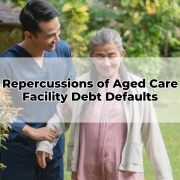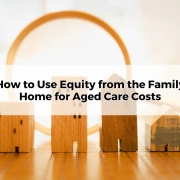Navigating financial options in residential aged care
Table of Contents
ToggleEntrusting a substantial sum of money to secure a place in residential aged care may seem daunting, but understanding the intricacies can unveil financial benefits and savings on fees. A transition to a new living arrangement, particularly in a residential aged care setting, demands a substantial financial commitment. This could be in the form of a lump sum payment or ongoing rent-like payments for your accommodation.
Understanding the Financial Landscape of Residential Aged Care
When you decide to move into residential aged care, you’re essentially transitioning into a new living space that is supported by a team of carers. A significant cost in this process is securing your room. The price for this space is often presented as a large lump sum, known as a Refundable Accommodation Deposit (RAD). Alternatively, this can be transformed into a Daily Accommodation Payment (DAP), or a combination of both.
While the thought of parting with a hefty amount of money upfront can be intimidating for many, it’s vital to understand that a RAD is a secure and potentially financially savvy option, especially if your budget allows for it.
The Refundable Accommodation Deposit Explained
The RAD is fully refundable upon your departure from the care facility or in the event of your passing. This ensures that the money is returned to you or your estate, provided that all other fees have been settled on a monthly basis. Essentially, this means that the RAD is a recoverable cost.
Case Study: Jane's Journey with RAD
Consider Jane’s situation: she moves into a residential aged care facility, facing a room cost of $700,000. After settling in, she decides to sell her property and pay the RAD in full. During her stay, she manages to cover her other recurring fees through her savings. Upon her passing, the care facility reimburses the entire $700,000 to her estate.
Government Guarantee and Interest Implications
It’s crucial to note that the repayment of your RAD is completely guaranteed by the federal government, provided that you’ve chosen an approved aged care facility. This eliminates the risk of losing your money if the provider faces financial troubles.
If you opt not to pay the RAD in full, you will incur an interest charge of 8.34% per annum on the outstanding amount. This situation is akin to an interest-only loan, where the interest accrued is non-refundable.
Understanding the Cost Benefits and Pension Impacts
While the RAD does not accrue interest, the cost savings come from avoiding the interest charges associated with not paying the RAD. Additionally, your age pension entitlements could potentially increase, as the RAD is not considered in the age pension means test.
Delving into Jane's Financials
To illustrate, let’s revisit Jane’s scenario. Initially, she was entitled to the full age pension of $28,514 per annum. Post the sale of her home, her bank balance surged to $1.3 million, which would typically result in the cancellation of her pension. However, by opting to pay the $700,000 RAD, her remaining bank balance was $600,000, boosting her pension to $24,127 annually.
This strategic move resulted in a combined saving and pension increase of approximately $81,177 per year, even after accounting for potential interest earnings had the money been deposited in a bank.
Seeking Professional Guidance
These financial decisions are complex and can be overwhelming, especially when encountering them for the first time. There are numerous factors at play, and this article has only scratched the surface. Engaging with a certified financial planner, specialised in aged care advice, is a prudent step to ensuring you make informed decisions that suit your comprehensive financial landscape. Aged Care Financial Advisers are at your disposal to assist you in navigating these choices, and can be reached at 1300 550 940.
Through understanding, strategic planning, and expert advice, navigating the financial aspects of residential aged care can lead to significant cost savings and enhanced financial stability.









